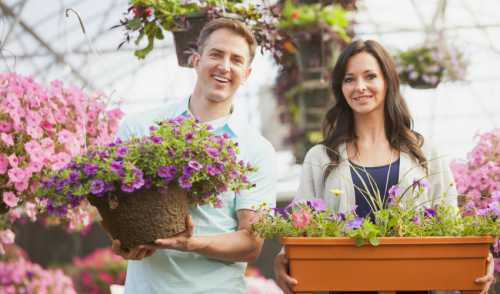
Helpful Hanging Basket Hints
Hanging baskets can be a fun and efficient addition to your container gardening efforts, giving you more planting space and adding visual height and interest to any area. These special containers do require some special care and consideration, however, to keep looking their best.
Where to Hang Baskets
There is no limit to where you can hang baskets of flowers, ferns, ivy, grasses, or other container plants. While the support hook does need to be strong enough to safely hold the weight of the mature plants, soil, container, and water, and it should be positioned safely away from areas where it may fall or tip in breezes, popular spots to hang baskets include…
- Along the roofline of a porch or deck
- From rafters in an open gazebo or pergola
- On hooks extending from a fence
- In a greenhouse to maximize growing space
- Crowning the arch of an arbor or archway
- From the roofline of an apartment balcony
- Indoors near windows or as living chandeliers
Once you start hanging different baskets of your favorite plants, you’ll discover even more options for where to position these easy and convenient containers.
15 Hints to Make the Most of Every Basket You Hang
No matter where you hang a basket or what you’ve planted at different heights, proper care will help keep your basket looking fresh and lush.
- Choose a basket that offers sufficient drainage so roots will not rot, but be mindful that porous baskets or those with extra drainage will dry out more quickly.
- Consider using larger baskets for more dramatic arrangements. Larger baskets will also require less care and less frequent watering because the extra soil will hold more moisture.
- Line your baskets with fiber inserts, sphagnum moss, or burlap to increase air circulation and drainage, or use a plastic bag with a few holes to help retain more moisture.
- Use a high quality potting mix formulated for containers, or blend your own with extra perlite or vermiculite for drainage and a handful or two of compost for extra nutrition.
- Choose plants that offer trailing, draping, or cascading structures to give more textural interest to the arrangement and take advantage of its elevated position.
- Group plants with 2-4 colors for the most aesthetically pleasing arrangement, and use plants of different heights, shapes, and textures for even more visual interest.
- There is no need to take a basket down to check if it needs water, just lift it slightly to test the weight to determine how much watering may be required.
- Water the basket 1-2 times per day during the hottest part of the year, or if winds dry the plant more quickly. Drought-tolerant plants will need slightly less water.
- Use an extendable watering wand or long spout to more easily water hanging baskets without needing to stretch or take the baskets up and down with each watering.
- Water thoroughly, until excess water drains through the bottom of the basket, to be sure moisture will reach all the roots in the container.
- Feed hanging baskets with a slow release fertilizer specially formulated for the types of plants you are showcasing. Avoid overfertilizing when growth is slow.
- Hang your basket in sufficient light for the plants you’ve chosen to be sure they will thrive. Rotate the basket 1-2 times per week for even sun exposure and growth.
- Inspect your baskets regularly for any signs of pest infestation, and take appropriate steps to eliminate those pests as soon as they are spotted.
- Trim and deadhead your plants often to keep a pleasing shape to the container and to encourage further growth and reblooming flowers.
- Always be mindful of the weather and bring your hanging baskets into a sheltered location if there is a risk of strong winds or freezing temperatures.
No matter what type of basket you choose, where you hang it, or what you want to plant in it, your hanging basket can be a luxurious focal point of your container gardening and a wonderful addition to your green space.
